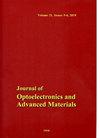Cu/Cu /p-Si/Al结构的电学特性
IF 0.5
4区 材料科学
Q4 MATERIALS SCIENCE, MULTIDISCIPLINARY
引用次数: 3
摘要
利用Cu薄膜在p-Si衬底上形成Cu/Cu /p-Si/Al结构。采用连续离子层吸附反应(SILAR)法制备了cu薄膜。室温下的电流-电压(I-V)曲线表明,Cu/Cu /p-Si/Al结构具有明显的整流行为。从正向偏置I-V和反向偏置C -2 -V特性出发,计算了Cu/Cu /p-Si/Al结构的势垒高度、理想因数和串联电阻等特性参数。应用热离子发射理论得到理想因子n=1.63,势垒高度Φ b =0.69 eV。在正向高电流密度下,观察到串联电阻效应。dV/d(InI) - /和H(I) - /样地的R s接近,R s分别为340.33□和346.24□。同样,由C -2 -V特性计算出的势垒高度从0.523 eV变化到0.601 eV。利用半对数正偏I-V特性,得到了多层器件界面态的密度分布。从价带顶部到中间间隙,随着偏置电压的增加,nss几乎呈指数增长。本文章由计算机程序翻译,如有差异,请以英文原文为准。
The electrical characteristics of Cu/CuS/p-Si/Al structure
Cu/CuS/p-Si/Al structure formed using CuS thin film on p-Si substrate. CuS thin film has been grown with using Successive Ionic Layer Adsorption and Reaction (SILAR) method. The Cu/CuS/p-Si/Al structure has demonstrated clearly rectifying behavior by the current-voltage (I-V) curves studied at room temperature. The characteristic parameters such as barrier height, ideality factor and series resistance of Cu/CuS/p-Si/Al structure have been calculated from the forward bias I-V and reverse bias C -2 -V characteristics. The ideality factor and barrier height have been obtained as n=1.63 and Φ b =0.69 eV by applying a thermo-ionic emission theory. At high current densities in the forward direction, the series resistance effect has been observed. The values of R s obtained from dV/d(InI) - / and H(I) - / plots are near to each others (R s =340.33 □ and R s =346.24 □, respectively). In the same way, the barrier height calculated from C -2 -V characteristics have been varied from 0.523 to 0.601 eV. Furthermore, the density distribution of interface states of the multilayer device has been obtained from the semi-log forward bias I-V characteristics. It has been seen that the N ss has almost an exponential rise with bias voltage from top of the valance band toward to mid gap.
求助全文
通过发布文献求助,成功后即可免费获取论文全文。
去求助
来源期刊

Journal of Optoelectronics and Advanced Materials
工程技术-材料科学:综合
CiteScore
0.90
自引率
20.00%
发文量
0
审稿时长
6.5 months
期刊介绍:
The Journal of Optoelectronics and Advanced Materials (J. Optoelectron. Adv. M.) appears with 12 issues per year and publishes papers in the field of optoelectronics, photonics, and new advanced materials (nonlinear optical materials, crystalline and non-crystalline materials, nano-structured materials, magnetic materials, functional and smart materials, materials based on polymers, biomaterials) of relevance for optoelectronics and photonics.
 求助内容:
求助内容: 应助结果提醒方式:
应助结果提醒方式:


